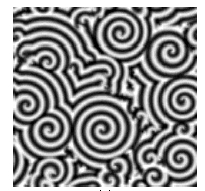|
Nonlinear Dynamics and Complexity in
Optical Physics:
Pattern
Formation and Turbulence in Optics
Pattern formation and spatiotemporal complexity is currently a young
and exciting subject in the field of nonlinear dynamics and chaos. It concerns the tension between order and
randomness through which patterns spontaneously emerge and disappear into
turbulence. Spatiotemporal chaos
(turbulence) occurs when different types of motion, excited in local
regions in an extended system, interact to destroy the spatial coherence of
the system concurrent with the onset of temporal chaos. In optics this arises from local
nonlinearity and diffractive coupling in spatially extended systems such as
broad area devices and lasers. This
phenomenon in continuous physical systems is described by partial
differential equations.
Our investigations are by means of computational simulations augmented
by theory through stability and bifurcation analysis and symmetry
consideration. Recent contributions
include numerical observations of different pattern formations, in
particular spiral waves and turbulent waves, in lasers, analysis of optical
spiral-forming geometry, and explanation of their physical origin in terms
of nonlinear optical interactions.
Current research interests of the group are in the areas of optical
excitability and associated pattern formations, both in lasers and
nonlinear optical devices.
Excitability underlies a class of pattern forming phenomena normally
associated with chemical and biological systems. Our research into this subject explores
the universality of this phenomenon and its potential applications in
modern optical technology.

Figure: Transverse field of laser
emission from a broad area laser showing spiral wave pattern [Yu et al,
J. Opt. B 1, 25-30 (1999)].
These theoretical research programmes have strong interaction with the
experimental research activities in the Department. Currently, a combined theoretical and
experimental effort is in the areas of control of chaos and spatiotemporal
chaos in optical devices. Here the
theoretical work has resulted in the development of new algorithms for
controlling patterns in both low-dimension and high-dimensional dynamical
systems, some of which have been successfully adopted in experiments.
Control and synchronization of chaos is a rapidly emerging area in
nonlinear dynamics offering unique strategic dividends. Specifically, secure communications,
coherent laser arrays, parallel information processing, and pattern
recognition and memory.
Programmes address, through experiment and theory, non-invasive
control approaches to stabilize and manipulate unstable periodic motions in
low dimensional systems and unstable patterns, or images, in high
dimensional systems.
Research
areas:
·
Spontaneous Pattern
Formation and Turbulence
·
Synchronization of
chaos in coupled lasers and laser arrays
·
Control and
tracking of patterns in broad area lasers and optical devices
·
Signal processing
and real time tracking of moving targets
Back to Research Reviews'
Page
|